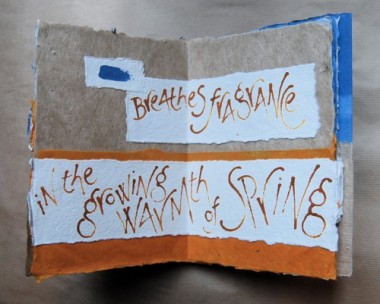Burns’ Night is to many of us the great winter feast, an occasion to celebrate not only the life and works of the Immortal Bard, but to reinforce a worldwide sense of community embodied in his songs and poetry. For the last few years I’ve been making a series of artist’s books as contemporary illuminated manuscripts, taking as a theme the turning year and the dance of the seasons, and Burns’ poetry has been a great inspiration.
Seasons Dancing is a concertina book that opens out to form a standing circle, a continuous double-sided ring of words nearly 5 metres in circumference, with a flowing, lilting circle of lines from Burns’ poems evoking each month page by page and joined at the turn of the year, flowing onward like a sound wavelength, following the cycle of the year – regular, repeating, ever new; it folds down to a manageable largish book.
Burns’ Year: Love and Freedom is in the form of four books, one for each season.
Each of the four books is made from a single sheet of handmade paper (at 2 metres x 80cm, some of the largest handmade paper in the world, made in India by Khadi Papers), torn and folded into a sequence of pages, but readily reformed to its whole state, unfolded and opened out to spread before you this sacred space open to all, like a magic carpet that transports you to another time and place, but which you can also fold up and carry about with you – the essence of ‘book’, in fact.
In the four books that make up Love & Freedom: Burns’ Year, some of Burns’ ideas about inequality, oppression and dispossession (‘how things are shar’d’), his profound sense of home and exile, and his awareness of the solace of love are bought together by means of his characteristic association of radical politics and the consolations of Nature (‘free alike to all’).
Themes of fragmentation, dispersal and restoration/reconstruction are present not only within the texts and the form of the books, but also within the materials and making processes: like the threads of a woven plaid, the flocculating molecules of the clay body, the fragments and scraps of paper pulp reform to a unity in the great sheet; like the bricks in a wall, or the parts of a musical score, the individual elements are reconstructed to wholeness.
Each book follows on from the one before, as do the seasons. In Winter Wild, the dispersal of autumn hardens into a solid state, in a setting of Burns’ poem O, wert Thou in the Cauld Blast, mapped and contained by the plaid (based on the Lennox tartan, to reference the tune for which Burns wrote this song, Lenox love to Blantyre). The fragments come together and resolve to a paradoxical equilibrium, the icy wind countered by the protecting plaid – a rather slight defence, we may feel, but time- honoured. Here is the book, page by page:
As you’ll have seen, I’ve worked with fine thin colours, an icy silver grey and some delicate threads of wintry sunlight, the small marks defining the threads of the plaid made with the same driftwood twig that I used for the lettering. I’ve aimed to use the colours to reflect and respond to the colour and mood of each line, each word of the text, as one would in setting a text to music. To balance the different colours of the text both phrase by phrase and within the overall whole image is very important for how the book works in its dual character.
The colour palette of the four books is essentially the same, concentrated or diffused in tone according to the season’s particular light, and with a characteristic hue added for each season: silvery grey for winter, golden yellow for spring, azure for summer and russet for autumn. This colour is highlighted on the individual slipcase for each book, with its linen draw-tabs, and brought together in the box which houses the four books.
I’ll be describing each book in detail as the seasons turn throughout this year, as well as showing some more pages of the months from Seasons Dancing.
Both Seasons Dancing and Love & Freedom: Burns’ Year are now part of the National Library of Scotland‘s collection of artists’ books.


























































































